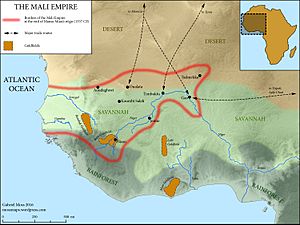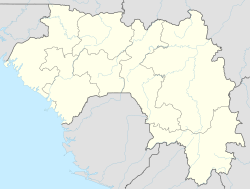Niani, Guinea facts for kids
Quick facts for kids
Niani
|
|
|---|---|
|
Village
|
|
| Country | |
| Region | Kankan Region |
| Prefecture | Kankan Prefecture |
| Time zone | UTC+0 (GMT) |

Niani is a small village in the country of Guinea. It is found in the eastern part of Guinea. The village sits on the left side of the Sankarani River. Niani is famous because many people believe it was once a very important capital city of the powerful Mali Empire.
Contents
Where is Niani?
Niani is located in the far eastern part of Guinea. It is on the west bank of the Sankarani River. This river is always easy to use for boats. Rocky hills surround the village. Niani is also near a forest. This forest was a source of valuable items. These items included gold, kola nuts, palm oil, and ivory.
Niani's Amazing History
Niani is often thought to be one of the old capital cities of the Mali Empire. Some experts think it became the capital in the early 1100s. This happened after an older capital, Dioliba, was no longer used. A traveler named Leo Africanus wrote about Niani in the 1500s.
Niani as a Capital City
Some historians believe Niani was the capital for a long time. It might have been the main city from the 1300s to the 1500s. A historian from the 1300s, Shihab al-Umari, called the village Nyeni. He said it was "the official name of Mali." This was because it was the main city of the kingdom.
Storytellers and Trade
Even today, special storytellers called Griots live in Niani. They help keep the history of the Mali Empire alive. Messengers on horseback left Niani every day. They brought news from all over the empire. Many Arab traders also settled in Niani. They came because of trade routes across the Sahara Desert.
A Busy City
Niani was a very busy place. In the 1300s, it had at least 100,000 people living there. The emperor, called the mansa, lived in Niani. His royal court was also there. Niani was a big center for trade and business. It was a stopping point for two main trade routes. One went north, and the other went south.
The city also had soldiers to protect the empire. The Mansa had large workshops in Niani. Here, metal was shaped and worked.
Famous Buildings
The emperor Musa I of Mali hired an architect from Spain. His name was Ishak al-Tuedjin. He built a special meeting room in Niani. It was square with a round roof, called a cupola. The room was decorated with beautiful designs. A historian from the 1300s, Ibn Khaldun, called it an "admirable monument."
After the 1600s, the Mali Empire became weaker. Niani then lost its importance. It slowly became a small village again.
Finding the Old City
In the 1920s, people started digging to find old parts of Niani. This is called archaeology. Later, in the 1960s, more digs happened. These digs showed that many people once lived around Niani. The old homes were spread out. There were small villages for different groups of people. These included metalworkers and fishermen.
Archaeologists found parts of the old Arab area and the royal town. They found stone house foundations. They also found the mihrab of a mosque, which is a special prayer niche. Walls around the royal town were also found. Old writings say buildings were made of beaten earth bricks. The roofs were often round or shaped like a camel's hump. Because of Niani's location, these buildings needed constant repair.


